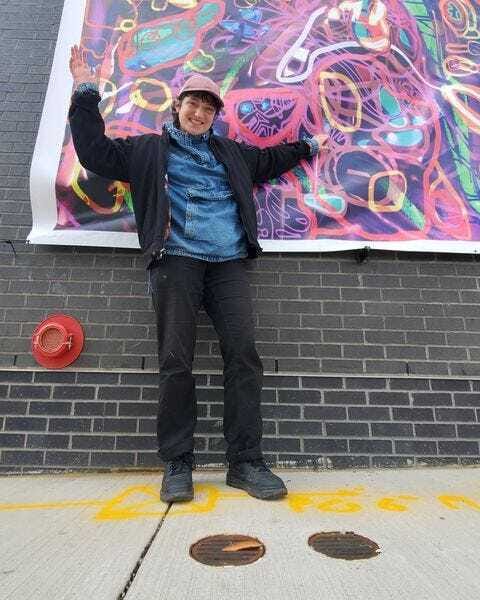- Creativity for Good
- Posts
- performance, play, and the power of community
performance, play, and the power of community
creativity q&a with jules malzof
If I’m a broken record about anything, it’s that art, no matter what form it takes, doesn’t exist in a vacuum. Art never simply exists, independent of the world — it is inextricably connected to its creator, to its audience, to the moment it was created and the moment it’s perceived. Books are written so they can be read, paintings painted to be witnessed, music played to be experienced. Art is transformative and transformable. We change it, and it changes us.
Some creative works, though, are created with the explicit intention of audience participation and interaction — with not just thought to how the audience might experience the piece, but with a pedagogic intent that includes attention to how the audience might be guided through that experience in profound and meaningful ways.
For this month’s Creativity Q&A, I spoke with Jules Malzof, an intermedia artist, DJ and community leader based in Pittsburgh, Pennsylvania. Jules’ work uses digital media, paint, installation, performance, sound, and audience interaction to create experiences with an eye toward building community and speaking truth. We chatted about what it means to use creative work as a tool for bringing people together, encouraging dialogue without shame or guilt, and how the power of play and joy in an artistic experience can make all the difference.
creativity q&a with jules mallis: community, art, and conversation
Tell me a little bit about what you do and how you got started — What's your elevator pitch for what you do creatively?
I am a multimedia artist. I make visual art and music and do a lot of projects that bring the two together. A lot of my work is audio-visual, work that responds to the other components.
My creative practice is very much grounded in drawing and painting, which gets incorporated into video art, live visuals and projection mapping. I have gotten into using music as a tool to further create the experiences and environments I'm working to cultivate. I also DJ, and have been dabbling in making music as well. Whenever possible, I bring it all together and do live visuals for music events or score music to go with artistic pieces and ideally create stuff that is very much in sync with each other.
I've been making art my whole life and have always practiced self-expression and creativity, and utilizing art as a tool to bring people together and to facilitate dialogue and conversations that might be hard to have otherwise.
Tell me a little bit more about how the dialogue and conversation piece comes into play.
I'm interested in the way art can create experiences and bring people together, and I think part of that includes creating openings for people to talk about stuff that's happening that might be taboo or hard to talk about or confusing and so forth.
So sometimes it's very literal — I did a big street mural, and on the ground I painted prompts for engaging with it, and the street mural became an interactive game. It asked questions for the viewer. So that was like a very direct way of bringing dialogue and ideas so people really can question. For example, with that one, the mural is called "Who eats the most fruit?" and there were a lot of fruit painted throughout the street, to be incorporated into a game… you could jump across the fruit and count how many you could jump on. It's also a place where people eat food. There are business workers who come down there to eat, and there's also a really large unhoused population that also hangs out around there — just people from all walks of life, so the questions and game along the street intended to interrogate those dynamics (inequality, capitalism) from a playful yet agitational street mural game.
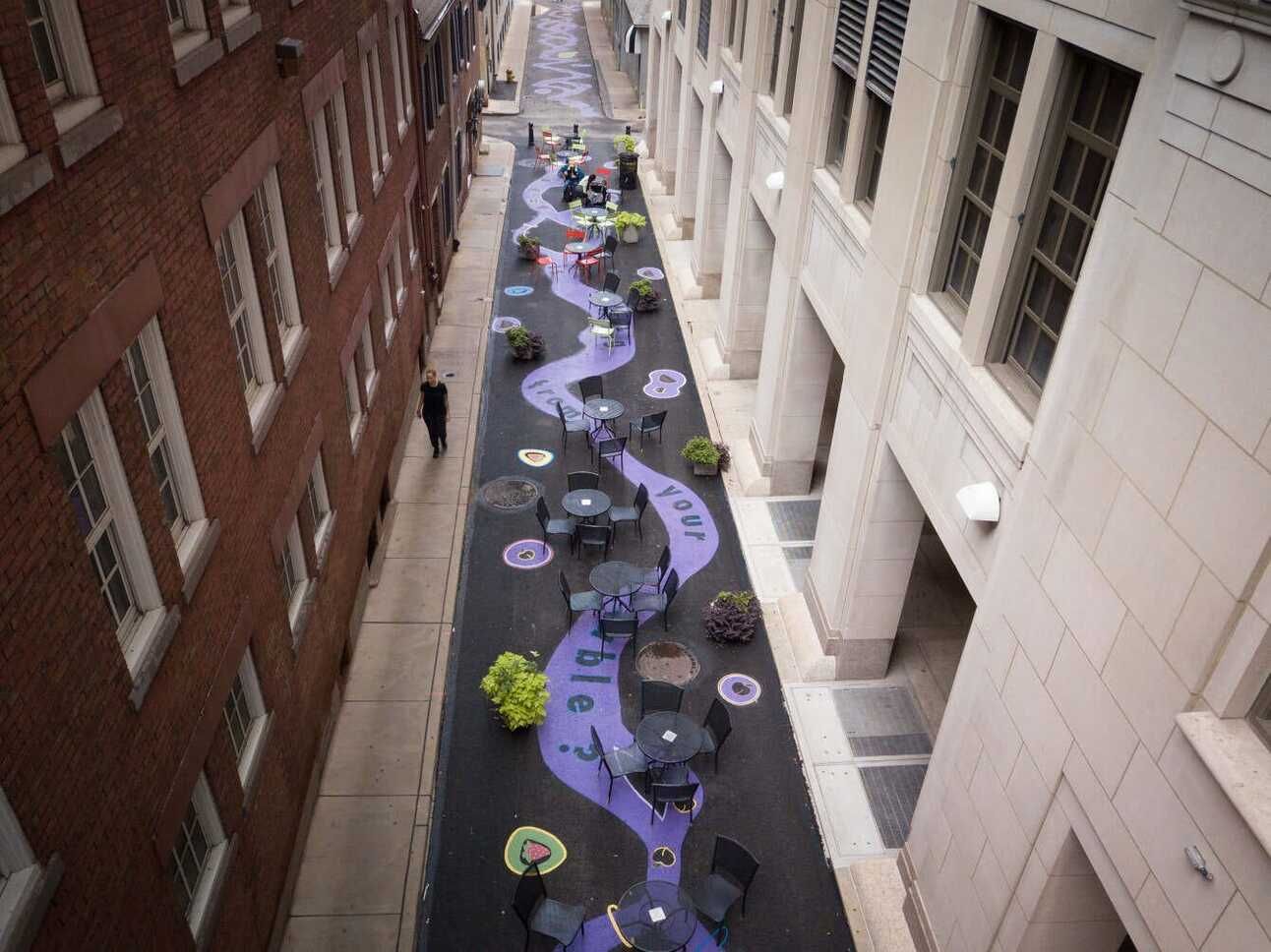
It became an opportunity to try to get people to really think about the space they take up and like what they're doing and where they are. Some of the questions were like, "Who's missing from your table?" and there are tables set out there. So it aimed to get people to think critically or contextualize their own experience further and to support self -awareness and increasing insight into the self.
I've done some performance art. I'm part of a creative space called BOOM Concepts, which just celebrated their 10-year anniversary, which is very cool. I've been part of BOOM since the beginning, and I'm currently supported as a studio artist there. I was part of a performance ensemble, and we put together a series of physical theater pieces. In that performance, my friend D.S. Kinsel and I played Jodi and Cody, and we were realtors/tour guides who took the audience through an actual neighborhood and through a building that we all put an installation into, and planted with performers into. It was a commentary and questioning about how our communities develop in ways that are both responsible and irresponsible, and what parts we all might play in that, and how it can impact not just our current realities but also how it connects and interacts with our past and the future.
You really focus a lot about community and community engagement. How do you bring the issues and questions that you really care about into the work that you do to encourage those connections in the people who interact with your work?
It's through being in dialogue with other people. Whether I'm talking with my collaborators or other artists, or people in the general community, I can better understand what people are looking to learn more about and dial in on further. Through being observant and in conversation with others, it has allowed me some insight on what I might want to focus on bringing into a piece when I can.
One of the things that I talk to people a lot about is sort of like the role of social media and the role of like the internet and like being connected to broader audiences. And what I love about your work is that it's very local. It's very plugged in to like your actual community in Pittsburgh. Can you talk a little bit about what it's like to be doing your work like with people in person, rather than online?
That's a great question. I've always been really engaged in community work. I moved to Pittsburgh in 2008, and quite immediately started working multiple jobs. A lot of them were very community-based. So within a year, I was building and teaching art curriculum to students in local public schools. And from there on, I was teaching youth for the next decade, running youth bike and artistic programs, and doing all kinds of different community endeavors. My work continues to be very community-based. I'm very invested in my local community, and that comes with being engaged and involved and connected to what’s going on locally.
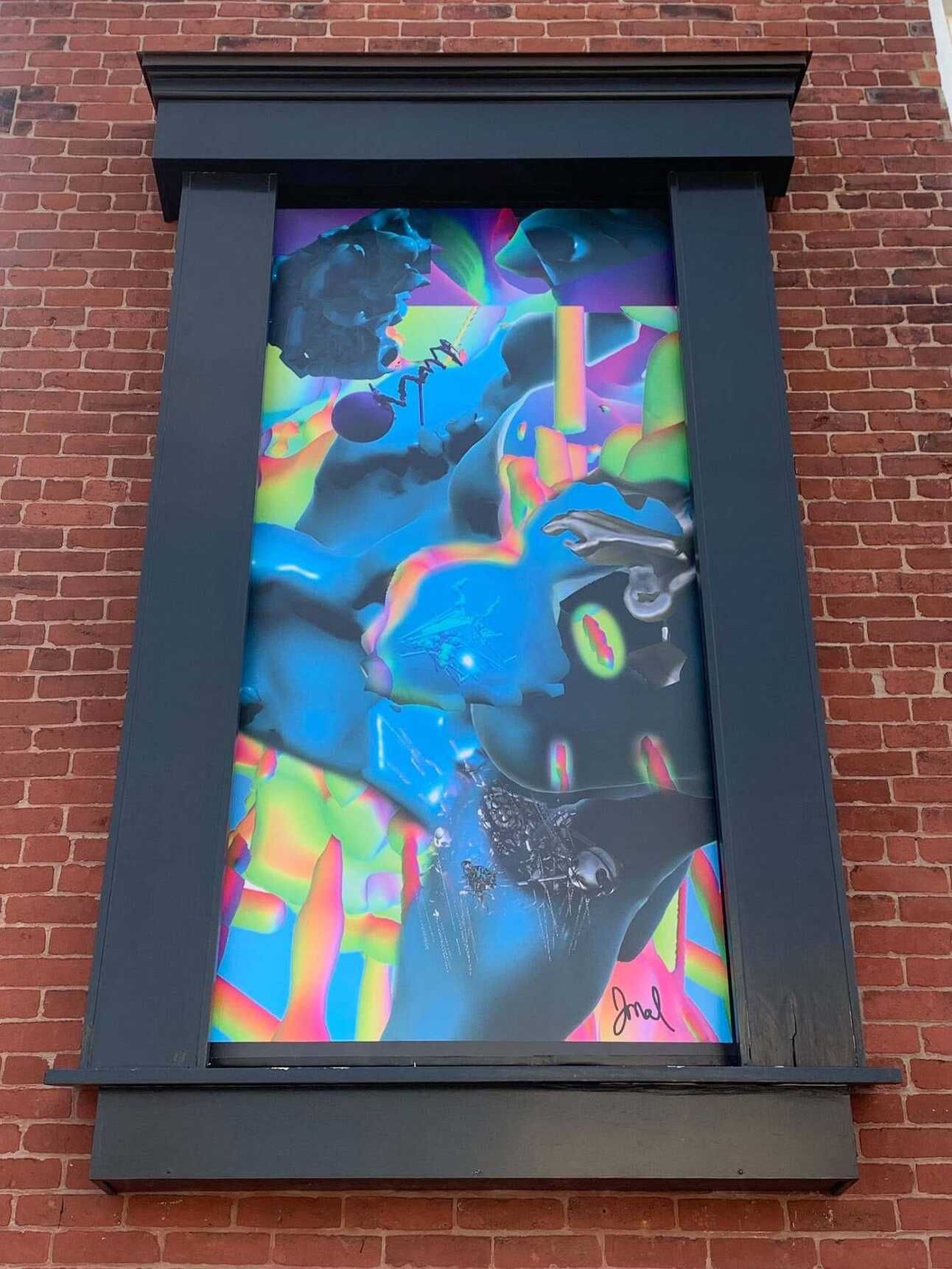
I like to have conversations. So being that I'm immersed and connected and empathetic about the people I live with, it pushes me to want to push my local community further, too. I try to offer a gentle but strong nudge to people to further develop ideas or thoughts, and be more critical of what's happening around them, or to them, or by them.
Ultimately, using creativity is an extension of the way I live and my practice. By being so ingrained in community, it makes sense that my artistic practice would be so community-based. And the context of our environment would be so connected back to the work.
So that actually kind of leads me into my next question, which is potentially a bit spicy. So I think there's a pretty strong overlap between, you know, people who are doing sort of community-engaged creativity work and people who are also in some way doing nonprofit work and see that work as both in alignment and also sometimes in opposition to what they do in their "day jobs." I'm curious to know how you see the relationship between the work you do creatively and the work you do as a nonprofit professional.
I think it's really special and wonderful to be able to use your voice honestly and to really speak for yourself and be a vehicle for your ideas. It's really powerful to communicate your thoughts and ideas, especially if you're in a supportive way, trying to make the world better. It's really wonderful to be involved in different collectives or organizations that support community-based work. All of that stuff is really important and holds a really great role. Being able to use your own voice fully and being able to express yourself creatively is really special and unique, and not really something you can always do through organizations because they have a specific goal that is just different from your individual goals.
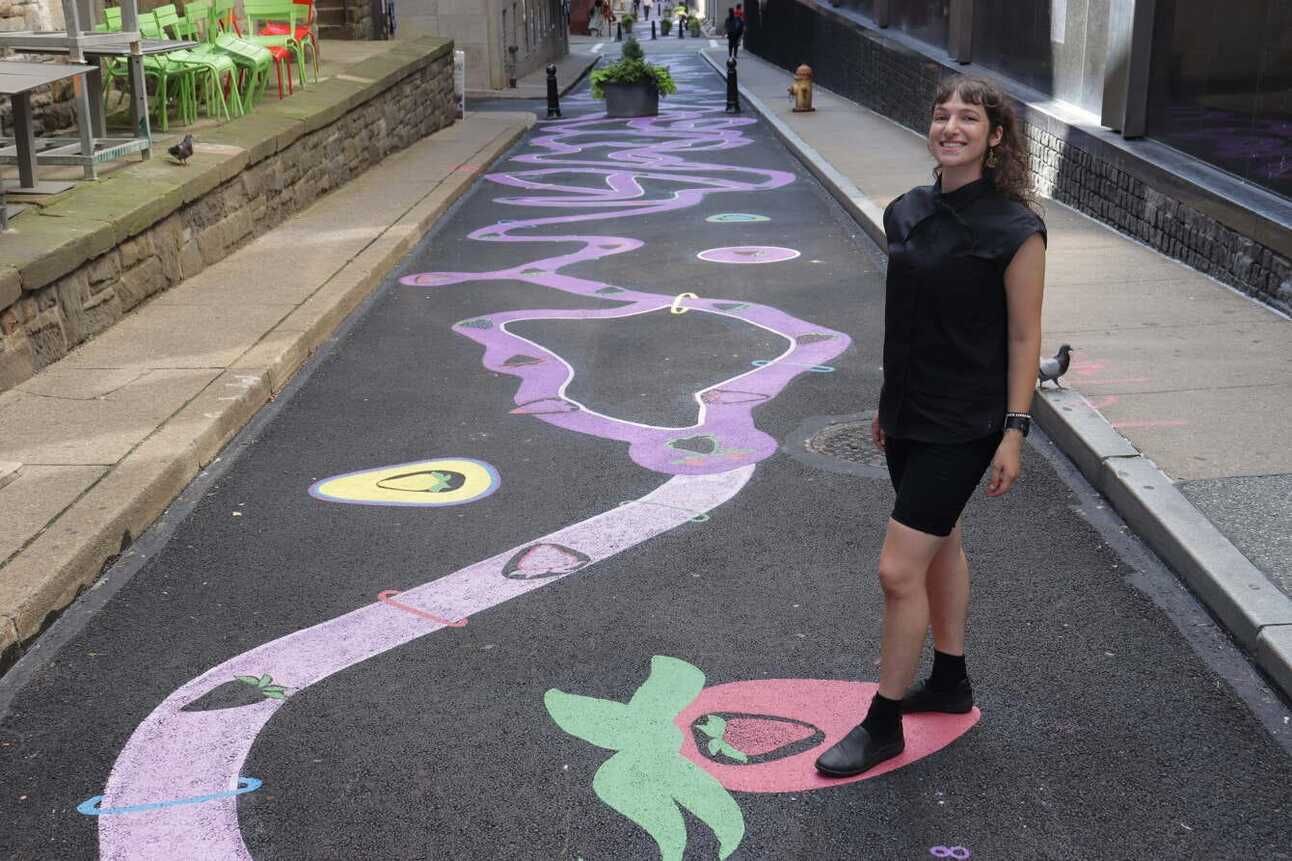
It's important to me to be able to have that full range of expression without needing to curate it for a specific presentation. Working with nonprofits is very focused. You're focused on one main mission, or specific programs, whatever it might be. That's all great, but you've got to really be focused. And by being limited by those goals, it helps you to go deeper with them so that there's a lot of value to that. But there's so many things outside of that that also need to be explored and touched upon. And so for me, using my personal voice and creative expression is really important to get my ideas out and to not be silenced.
That's a fantastic answer.
Ha, thank you.
You talked a little bit about some of the projects you've done — the performance art piece, the fruit mural. Are there other collaborations or projects that you've done that stand out to you as like, "This was so good, I'm so glad that I did it."
Ooh, this is a fun question. So, I've been doing a lot of projection mapping.
Can you talk about what that is for the uninitiated? AKA me?
So, I've been doing live visuals and VJing for over a decade. People are very familiar with DJing, but not really with VJing, where you're basically taking video content — like you could be taking VHS tapes as the most classic form and altering it, mixing them live, and you're altering everything from the signal, the frequency, the color, the shape. Literally altering the media physically. It's really cool. And you can really create something special with it. I've been doing that type of stuff for a long time, mostly doing digital mixing. And the majority of the time, I use all of my own original content. So instead of mixing videos without footage, or movies, I create my own moving image and use that for mixing. It's mostly all original stuff, and you can really create these immersive environments and digital pieces.
So projection mapping means that you're taking those images and instead of just projecting it on the exact rectangle that the projector or TV gives you, you can actually map the shapes. People are familiar with this concept of picture in picture, where you have a little corner picture and then you have the smaller picture. With projection mapping, imagine picture in picture, but you can create all the shapes you want, as many as you want. And say you have three different channels of content at one time — You can set each little piece to be playing its own channel or an overlap of the channels. And you can change whether it's zoomed in or zoomed out, the opacity of the channel, all these different customization options. Projection mapping is a way of really taking your visuals and making them more integrated into a space through customizing the size and shape to fit.
That's something I really love doing, and incorporating into my visual practice. So I've been doing immersive installations, where maybe you enter into a room at a party or an event or exhibition. And that room has projection mapped visuals onto the structure of the room. We could bring in objects, found objects from the building and map onto them. And so it really starts to bring different elements to life in a space and creates this immersive experience. You can walk through it, you can get in it. I also like to do playful pieces where there's always sound playing too. And the sound is ideally synced up with the visuals, which makes it really immersive and like, whoa, how's it doing that?
I did this one piece on the old Carrie Blast Furnace in Pittsburgh. And I put a projection - really, really huge - on the side of it with a mix that I made, a DJ mix and it was all synced up. The goal of the piece was to have people play with it, specifically playing with your shadows. So it's such a big piece, you stand in front of the projector, you're immediately passing shadows into this abstract world.
And so instead of this VR stuff where you're like, I'm in the world, it's like you're 3D in the 2D world… instead of being 2D in the 3D world or whatever. Your own shadow becomes your own puppet in the piece, and you can play with it. And it's fun. It's the type of thing where when kids see it, they immediately run up to it and just go nuts and play with it. That piece was really cool. And I got to replicate it a few different times in different spaces. So yeah, these playful pieces that are interactive and on display for many months at a time.
Then I did something really similar at Zach’s Crab Shack, that was on display for a couple months in Philadelphia. And so on and so forth. Durational pieces that are on ongoing display give more time for people to engage with it, especially a piece that is an hour and 40 minutes. So you could really spend time with it if you want. But I also do like one-night-only pieces too. And that's special. It becomes a special moment.
I'm so glad you brought up the idea of playfulness too. I think artists and creative people, sometimes we just take ourselves so seriously, we take the world so seriously, and then every now and then we do a project that is so focused on just taking joy in what we're doing and bringing that joy to other people. And part of the way we create change and we create impact is by creating these moments of levity and these moments of joy in our community, that's not any less important than critical engagement.
Yeah. It sometimes helps people bring their guard down in a way that helps them to then actually engage in a critical and serious manner. It's a fun approach and it's an effective approach.
People are more receptive to digging into conversations when they feel emotionally safe, and we do that by facilitating a space of comfort and a space of joy and a space of happiness so that people want to go back to those conversations.
Yeah.
No one wants to keep just having conversations that make them feel bad.
Right! It's so true. And, on top of that, it could be very memorable, because it was playful and fun, and you felt different emotions that weren't just horror. In the physical theater piece that I referenced, there's a lot of humor involved. There's a lot of farcical satire and silliness, but then it's also very uncanny and eerie, and some of the pieces are really serious and really devastating. I've gone to some of the performances where I'm witnessing the other performers, even while I'm still in character, and I’ve been crying because it's that serious. I don't know if it's that good to be crying while in character, so I have to put my sunglasses on, pretend I'm not crying because I'm supposed to be leading it, but it's all in the same piece. The power of feeling such emotions is really amazing.
So what's next for you? Is there anything that you're that you have in the works that you're looking forward to or excited about?
I'm playing three shows soon, all in the next couple of weeks, which is exciting, and putting out a couple mixes, so that's cool. The shows that I have coming up are fun because the first one is going to be a 30-40 minute live music set and VJ set, and it's going to be my first time ever performing live music in front of an audience in this way. I was in an orchestra when I was a child, but that was a little different. I have performed music live in front of people, but this is the first time that it's my own music that I'm creating. The added challenge of doing that while VJing live is some fun chaos that I'm excited to harness and just get into. That's cool, and it's really an opportunity to push myself in my musical practice to keep on giving myself outlets to try ideas out and encourage myself to do some of that stuff.
Artistically, I also have a new public art piece up. Boom Concepts, as part of their 10-year celebration, did a takeover of Penn Avenue where they're located and where there's a lot of art galleries. There's a big art scene there. It's been around for about 20 years with a gallery crawl. So BOOM Concepts commissioned me, printed my artwork on a large piece of vinyl, and they brought it on the side of a building called Pedantic, which is where another artist's residency exists and it's a new building. So that's up, and it's going to be up indefinitely. So I'm really excited about that. It's nice to have my own artwork up in my own community. It's exciting.
Jules Malzof is an intermedia artist, DJ and community leader based in Pittsburgh, Pennsylvania. Follow them on Instagram @jmal_malzof, or here on Substack at .
updates from shelly
Save the date — we’ve got a book launch event!
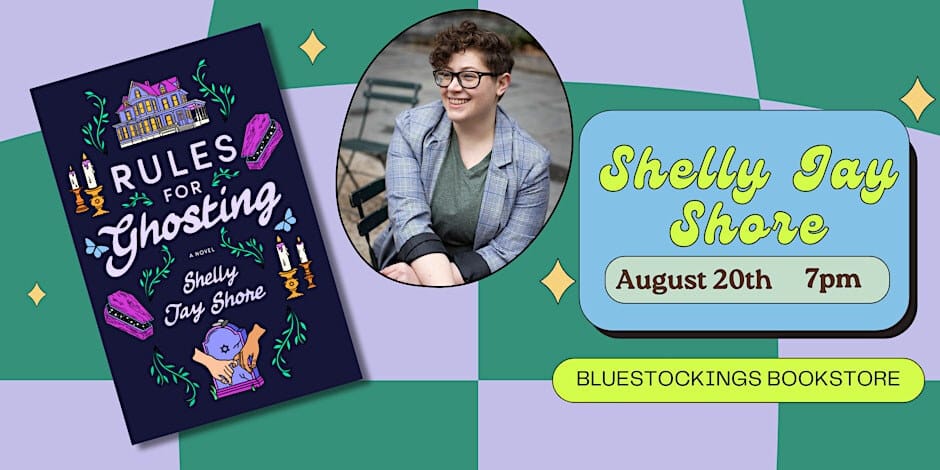
I’m so excited to be launching Rules for Ghosting at Bluestockings, an amazing activist center, community space, and feminist bookstore. I’ll be in conversation with the absolutely brilliant Haley Jakobson (you might remember her from a Creativity Q&A earlier this year!) and I am so so so stoked. It’s going to be great. Tickets go on sale in July!
Also, in case you missed it: We’ve got another Goodreads giveaway happening! Between now and June 10, enter to win one of ten print ARCs of Rules for Ghosting. They’re extremely beautiful, and you definitely want one!
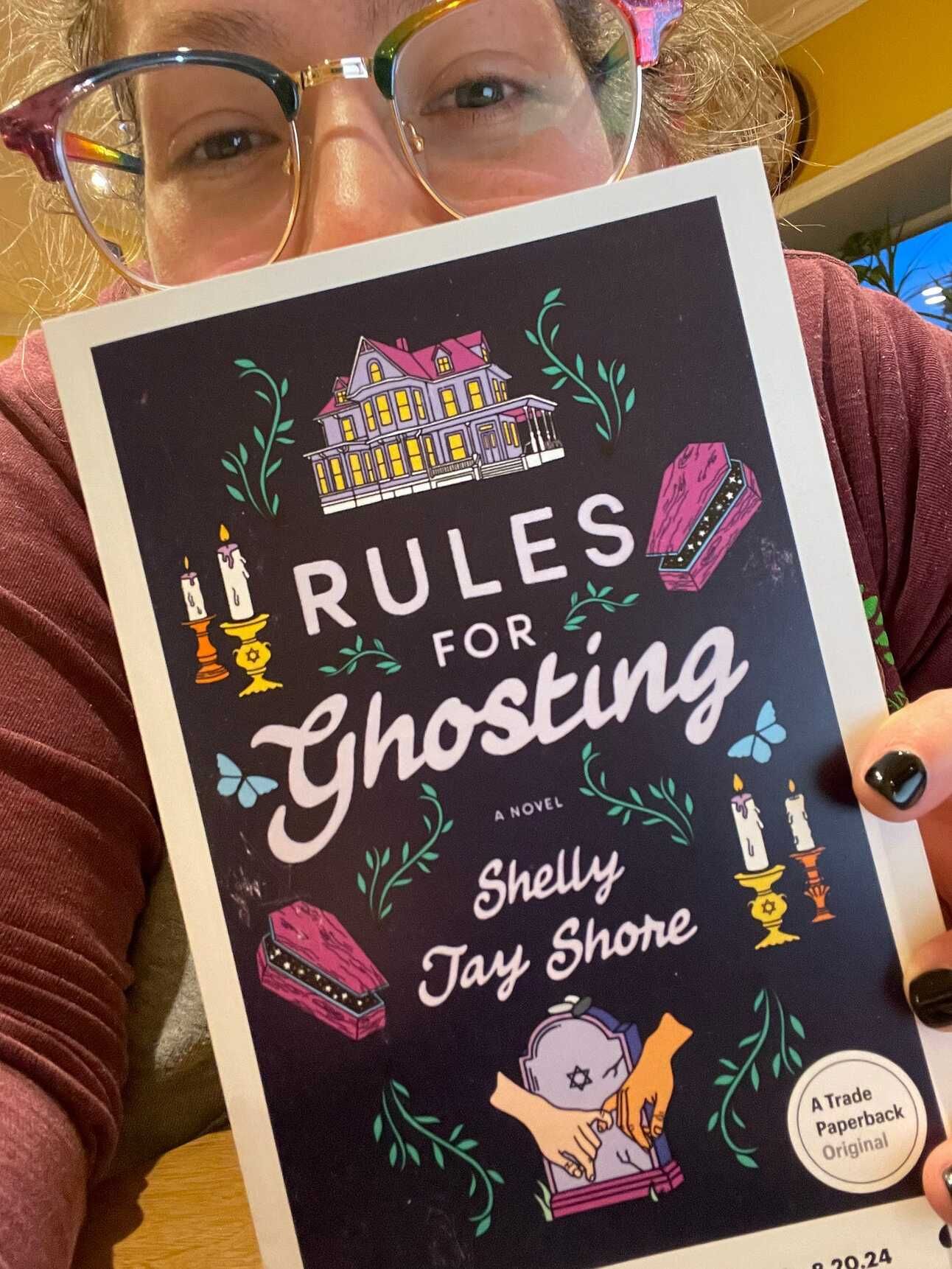
resources, links, and further reading
spotlight on: [performance] art as activism
read: “The Relationship Between Performance Art and Activism” by Zenaissance (Prazzle)
watch: “Ccreating Change: Art as Activism” from Great Big Story
donate: BOOM Concepts (jules’ pick!)
